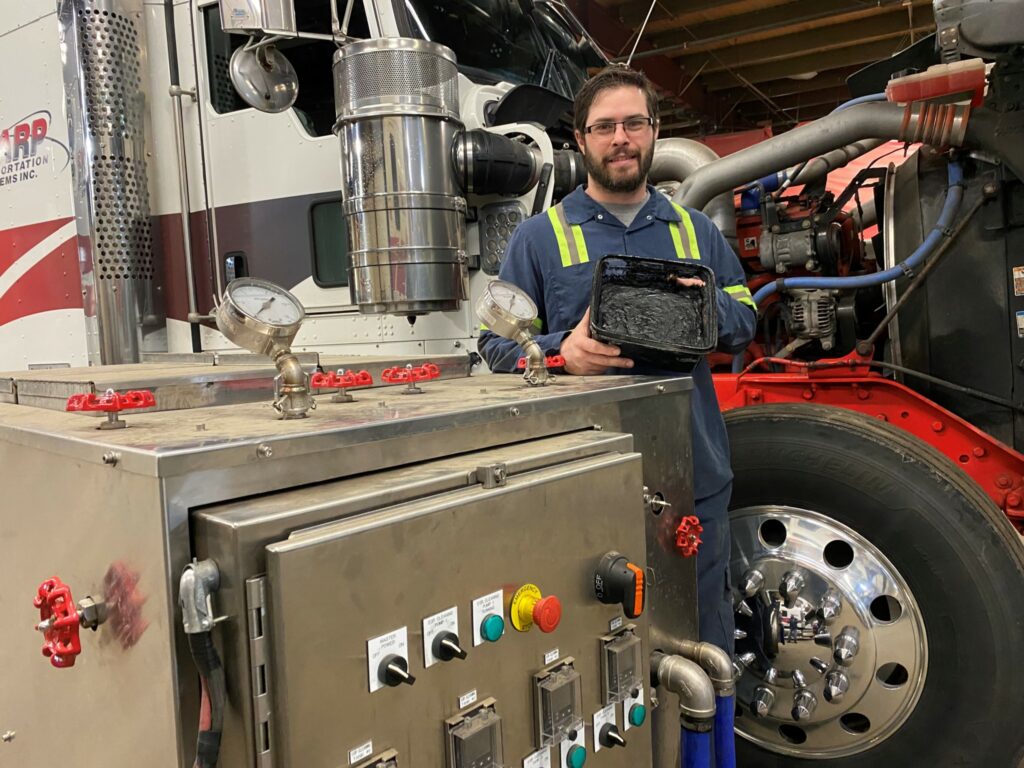Fleet Emission Solutions tackling fuel economy by cleaning EGR
Saving every penny is important when rising fuel prices eat into profits. And an Ontario-based company says it’s restoring 0.5 miles to the US gallon using a patented process that cleans truck EGR (exhaust gas recirculation) systems.
Scott Storey, owner and developer of Fleet Emission Solutions, describes the engine as an air compressor. If you can make it breathe better, it’s going to perform better, he says. A clean-running engine will be easier on aftertreatment systems, too.

Researching aftertreatment problems that trigger many fault codes and shutdowns, Storey discovered the downstream aftertreatment systems will function longer and more effectively if the original source of the emissions is addressed.
A cleaning costs about $2,500 a truck and is recommended once a year.
Storey says the greatest benefit is improved fuel economy. Half a mile to the gallon is typically worth about $800 to $1,200 in fuel savings a month, he explains.
“If we are able to save you one day of downtime per year, just the day of downtime is already paid for,” he adds.
Cleaning process
The cleaning process takes a day.
When a unit is picked up from a customer, data is scanned as the truck is driven to a workshop in Cambridge, Ont. Once parked, the engine is allowed to cool down. From there, it’s on to a major clean, a rinse, a secondary clean, and another rinse.
Fluid couplers are used to gain access to the EGR system, and sensor ports are cleaned to ensure they can read and meter correctly.
The cleaning product used in the process does not go into the engine since Storey designed a machine that creates a closed loop system.
The first stage usually takes one to two hours, depending on how full of soot the system is. Stage two takes about an hour. Stage three takes an hour, and stage four takes another hour. Then the system is evacuated and dries.
Preventative maintenance
Preventative maintenance is also performed. The tip of the diesel doser, the device that sprays fuel during diesel particulate filter regens, is cleaned to provide a good spray pattern. Emission harnesses around the engine are also checked. “One broken zip tie can shatter a truck,” Storey says.
The DPF pressure tubes are checked and cleaned because those restricted with soot may provide false readings to the engine control module (ECM) when it comes to regens.
The diesel exhaust fluid (DEF) doser is removed and a borescope is inserted to inspect any buildup where the fluid is sprayed and mixed. If a buildup exists, the pipes need to be cleaned.
The DEF pump filter is also changed, providing an opportunity to check that the DEF percentage is 32.5%, and ensuring there is no dirt in the pump assembly.
Zip ties
From there it’s a matter of inspecting wiring harnesses and routing. Sometimes they are run incorrectly within frame rails or on top of transmissions. And Storey says zip ties used by shops replacing a sensor can break over time.
He uses all sorts of his own zip ties in the process, including separating ties, button ties, and stainless steel zip ties, to isolate rubbing and chafing. He then ensures electrical and DEF lines run in parallel. If harnesses are mixed and gaps are created, stones or pebbles can find find a path and cut into the cables and wires.
“If you can keep those bundles tight, you can help eliminate some of the rocks and stones from getting into the harness. It is not 100%, but how many times does one wire cost you a week in the shop?” he asks.
Now Storey is working on a way to purify air going into the engine, with the goal of improving fuel economy and reliability alike.
“I am a tinkerer,” he says. “I tinker, I build stuff. I’m always thinking of how to make things easier.”
Have your say
This is a moderated forum. Comments will no longer be published unless they are accompanied by a first and last name and a verifiable email address. (Today's Trucking will not publish or share the email address.) Profane language and content deemed to be libelous, racist, or threatening in nature will not be published under any circumstances.